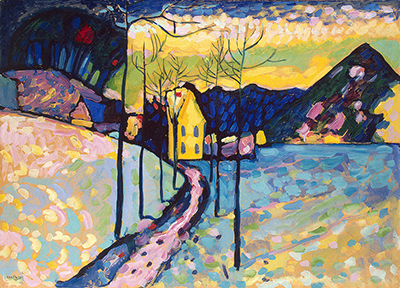This pretty landscape scene from 1909 is now a part of the collection of the Hermitage Museum in St Petersburg, Russia. It offers an early insight into the world of abstract art.
The simple composition features a small house at the end of a narrow path, which is lined by tall trees. They are devoid of any foliage, and we quickly realise that this scene is set in the depths of winter, with snow covering both sides of the path. In the background we see a suggestion of further buildings, perhaps, but this is clearly a rural spot, perhaps a small village. In the distance are a number of hills which jut out into the sky. Perhaps it is a forest that stands proudly on a mound on the left hand side of the painting, though the touches of blue and red oil might confuse that theory. Whilst we find a quaint picture here, it is the style of the delivery that makes this painting groundbreaking and exciting.
We immediately spot the daubs of paint which cover the sky and the fields in front of us. There is no attempt to merge these with what lies below. This is a fun style of working and entirely modern. Kandinsky would take colours from other areas of the painting and use them to supplement his larger areas of form in order to add interest and also a wonderful spread of colour which remains fairly consistent throughout the work. It is specifically tones of pink, white and a light blue which he decorates across field and sky, in a similar way to how the pointilists would construct form, with the careful placement of individual dots of paint. That said, Kandinsky is much freer here, not being too precise with where his dabs go, so long as they fill they correct areas and do not overlap each other too much.
This piece was produced on cardboard and one can actually see elements of it showing through on the edges of the painting. It is sized at around 98cm wide, by 76cm tall which is a fairly standard ratio for landscape art. There is an interesting balance in this painting between the thin, sad looking trees which are dormant until the spring, whilst the brightness of colour which decorates the snow laden hills feels uplifting and storybook-like. The artist was displaying his originality during this artwork and giving us a clue as to what would follow in the next few years of his career.




